Australian Catholic University: Service Quality Marketing Report
VerifiedAdded on 2023/01/20
|13
|3783
|69
Report
AI Summary
This report provides a comprehensive analysis of factors affecting the quality and delivery of higher education services, specifically focusing on the Australian Catholic University (ACU). It identifies five key factors: quality of faculty, syllabus, educational infrastructure, amount of research, and educational environment. The report then outlines a marketing promotion plan for ACU in 2020, including specific objectives to enhance these factors. The promotional mix incorporates advertising, public relations, personal selling, and direct marketing strategies. The report details criteria for measuring the success of the marketing objectives, such as increased diversity, government ratings, return on investment, student retention, and positive feedback. Finally, the report includes a budget and timeline for implementing the marketing plan, providing a complete strategic overview for improving ACU's service quality and attracting students.
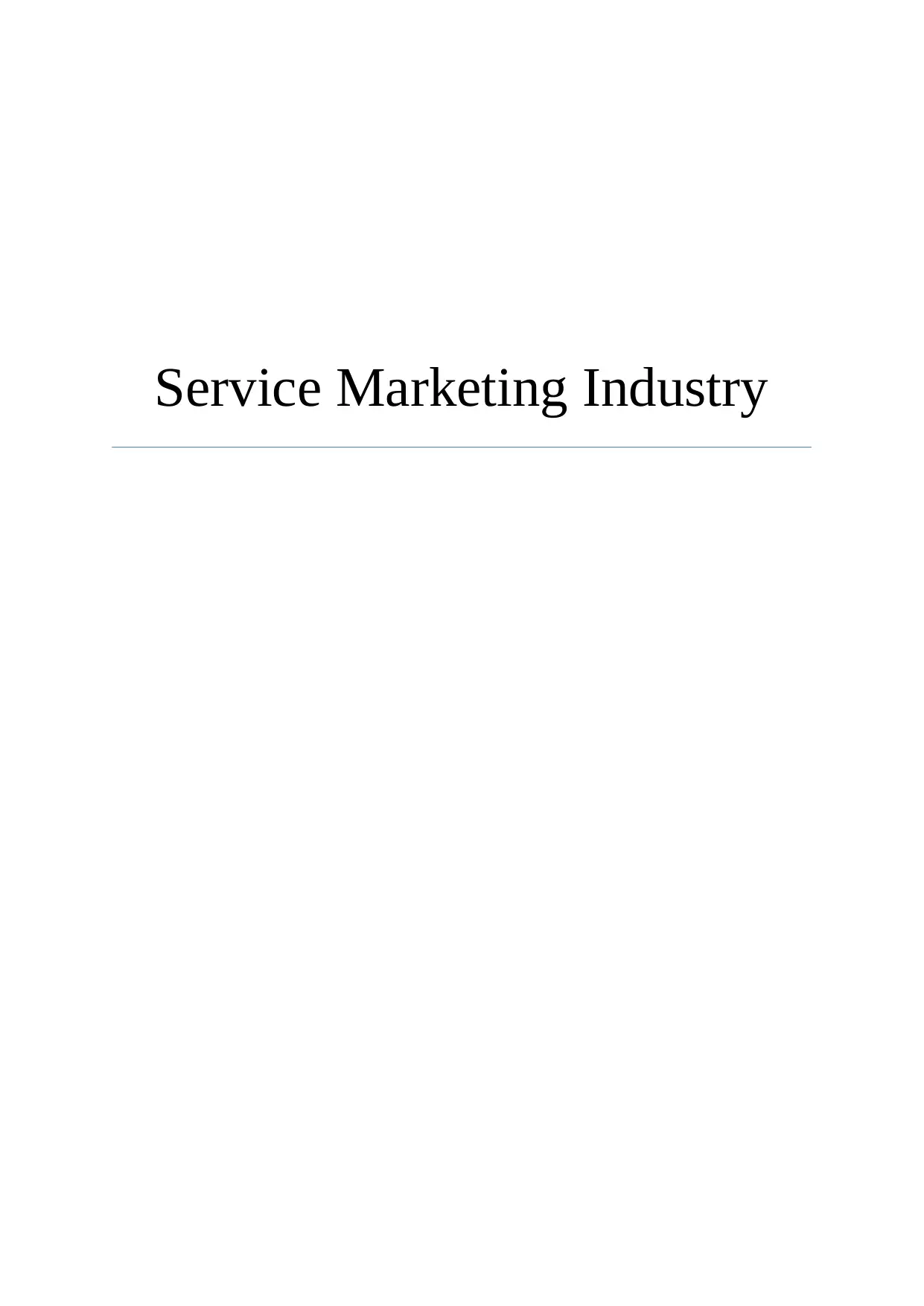
Service Marketing Industry
Paraphrase This Document
Need a fresh take? Get an instant paraphrase of this document with our AI Paraphraser
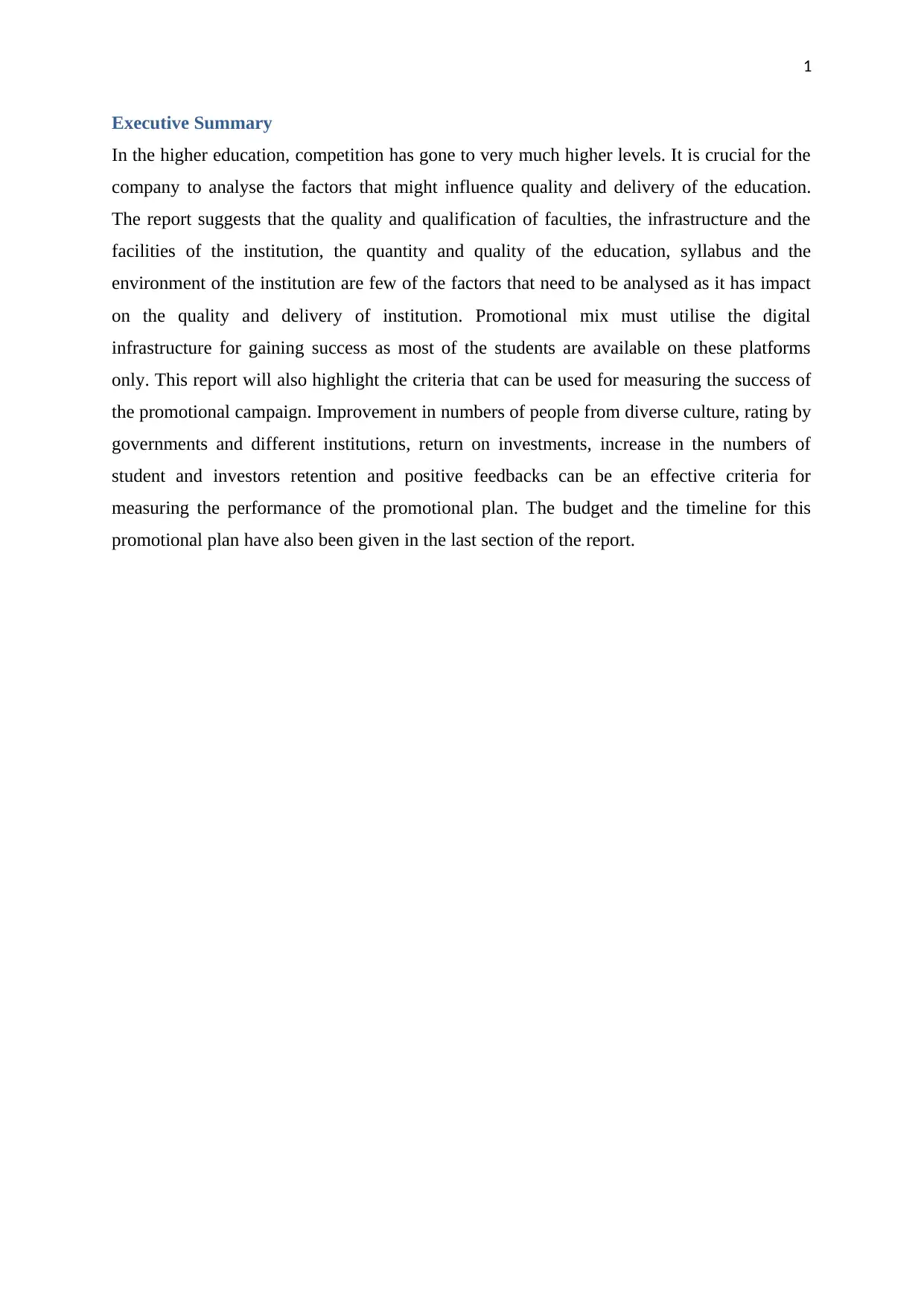
1
Executive Summary
In the higher education, competition has gone to very much higher levels. It is crucial for the
company to analyse the factors that might influence quality and delivery of the education.
The report suggests that the quality and qualification of faculties, the infrastructure and the
facilities of the institution, the quantity and quality of the education, syllabus and the
environment of the institution are few of the factors that need to be analysed as it has impact
on the quality and delivery of institution. Promotional mix must utilise the digital
infrastructure for gaining success as most of the students are available on these platforms
only. This report will also highlight the criteria that can be used for measuring the success of
the promotional campaign. Improvement in numbers of people from diverse culture, rating by
governments and different institutions, return on investments, increase in the numbers of
student and investors retention and positive feedbacks can be an effective criteria for
measuring the performance of the promotional plan. The budget and the timeline for this
promotional plan have also been given in the last section of the report.
Executive Summary
In the higher education, competition has gone to very much higher levels. It is crucial for the
company to analyse the factors that might influence quality and delivery of the education.
The report suggests that the quality and qualification of faculties, the infrastructure and the
facilities of the institution, the quantity and quality of the education, syllabus and the
environment of the institution are few of the factors that need to be analysed as it has impact
on the quality and delivery of institution. Promotional mix must utilise the digital
infrastructure for gaining success as most of the students are available on these platforms
only. This report will also highlight the criteria that can be used for measuring the success of
the promotional campaign. Improvement in numbers of people from diverse culture, rating by
governments and different institutions, return on investments, increase in the numbers of
student and investors retention and positive feedbacks can be an effective criteria for
measuring the performance of the promotional plan. The budget and the timeline for this
promotional plan have also been given in the last section of the report.
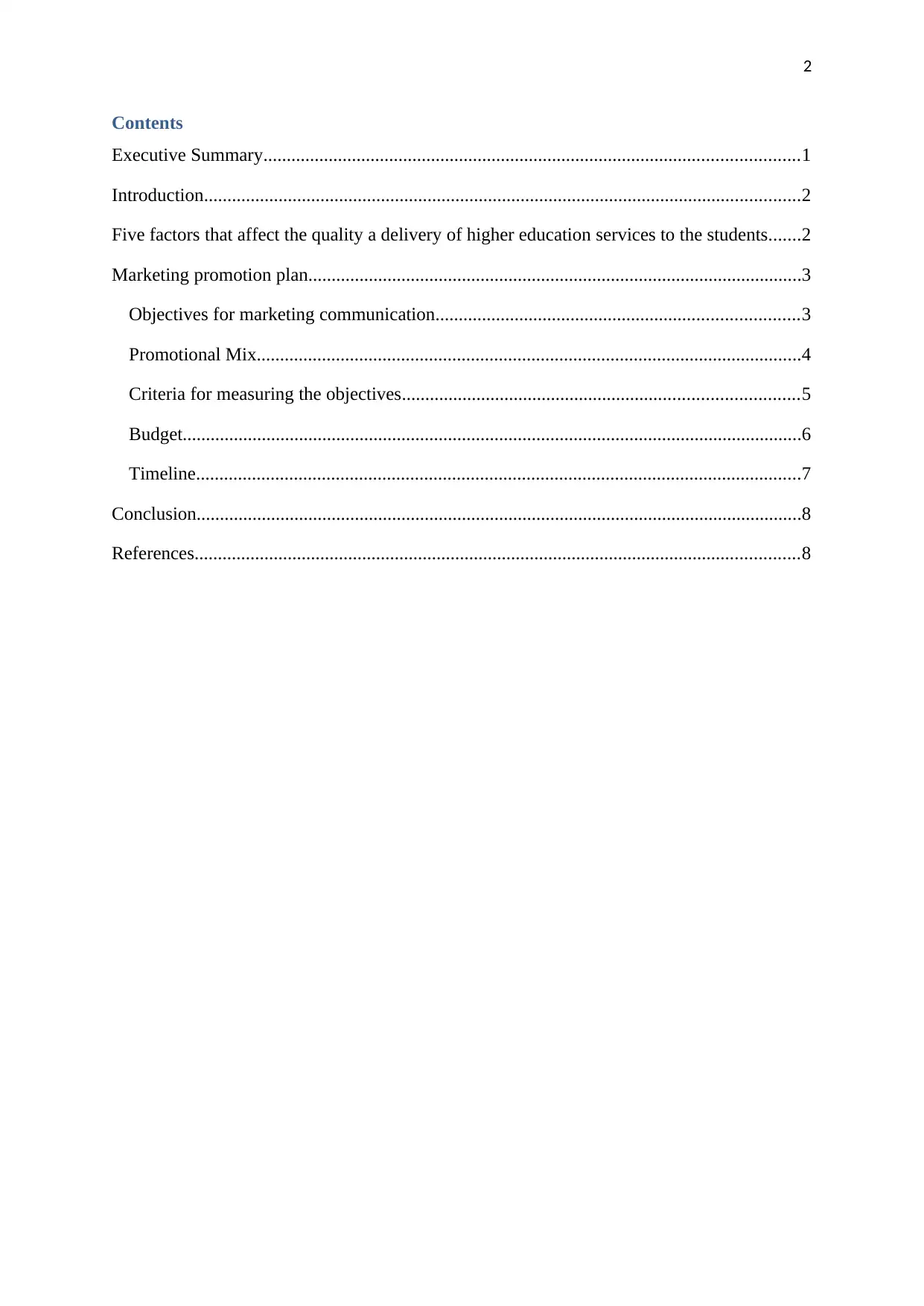
2
Contents
Executive Summary...................................................................................................................1
Introduction................................................................................................................................2
Five factors that affect the quality a delivery of higher education services to the students.......2
Marketing promotion plan..........................................................................................................3
Objectives for marketing communication..............................................................................3
Promotional Mix.....................................................................................................................4
Criteria for measuring the objectives.....................................................................................5
Budget.....................................................................................................................................6
Timeline..................................................................................................................................7
Conclusion..................................................................................................................................8
References..................................................................................................................................8
Contents
Executive Summary...................................................................................................................1
Introduction................................................................................................................................2
Five factors that affect the quality a delivery of higher education services to the students.......2
Marketing promotion plan..........................................................................................................3
Objectives for marketing communication..............................................................................3
Promotional Mix.....................................................................................................................4
Criteria for measuring the objectives.....................................................................................5
Budget.....................................................................................................................................6
Timeline..................................................................................................................................7
Conclusion..................................................................................................................................8
References..................................................................................................................................8
⊘ This is a preview!⊘
Do you want full access?
Subscribe today to unlock all pages.

Trusted by 1+ million students worldwide
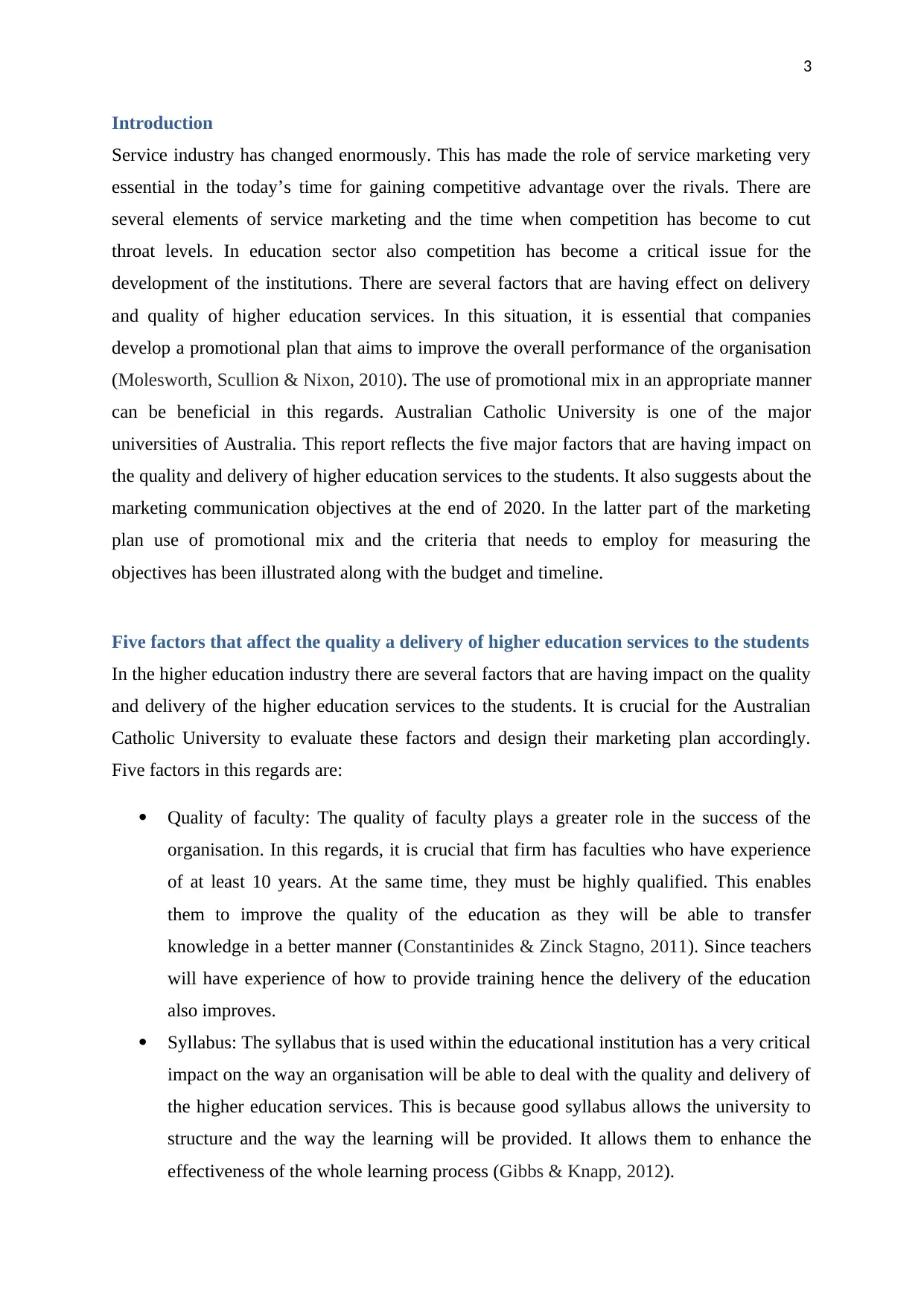
3
Introduction
Service industry has changed enormously. This has made the role of service marketing very
essential in the today’s time for gaining competitive advantage over the rivals. There are
several elements of service marketing and the time when competition has become to cut
throat levels. In education sector also competition has become a critical issue for the
development of the institutions. There are several factors that are having effect on delivery
and quality of higher education services. In this situation, it is essential that companies
develop a promotional plan that aims to improve the overall performance of the organisation
(Molesworth, Scullion & Nixon, 2010). The use of promotional mix in an appropriate manner
can be beneficial in this regards. Australian Catholic University is one of the major
universities of Australia. This report reflects the five major factors that are having impact on
the quality and delivery of higher education services to the students. It also suggests about the
marketing communication objectives at the end of 2020. In the latter part of the marketing
plan use of promotional mix and the criteria that needs to employ for measuring the
objectives has been illustrated along with the budget and timeline.
Five factors that affect the quality a delivery of higher education services to the students
In the higher education industry there are several factors that are having impact on the quality
and delivery of the higher education services to the students. It is crucial for the Australian
Catholic University to evaluate these factors and design their marketing plan accordingly.
Five factors in this regards are:
Quality of faculty: The quality of faculty plays a greater role in the success of the
organisation. In this regards, it is crucial that firm has faculties who have experience
of at least 10 years. At the same time, they must be highly qualified. This enables
them to improve the quality of the education as they will be able to transfer
knowledge in a better manner (Constantinides & Zinck Stagno, 2011). Since teachers
will have experience of how to provide training hence the delivery of the education
also improves.
Syllabus: The syllabus that is used within the educational institution has a very critical
impact on the way an organisation will be able to deal with the quality and delivery of
the higher education services. This is because good syllabus allows the university to
structure and the way the learning will be provided. It allows them to enhance the
effectiveness of the whole learning process (Gibbs & Knapp, 2012).
Introduction
Service industry has changed enormously. This has made the role of service marketing very
essential in the today’s time for gaining competitive advantage over the rivals. There are
several elements of service marketing and the time when competition has become to cut
throat levels. In education sector also competition has become a critical issue for the
development of the institutions. There are several factors that are having effect on delivery
and quality of higher education services. In this situation, it is essential that companies
develop a promotional plan that aims to improve the overall performance of the organisation
(Molesworth, Scullion & Nixon, 2010). The use of promotional mix in an appropriate manner
can be beneficial in this regards. Australian Catholic University is one of the major
universities of Australia. This report reflects the five major factors that are having impact on
the quality and delivery of higher education services to the students. It also suggests about the
marketing communication objectives at the end of 2020. In the latter part of the marketing
plan use of promotional mix and the criteria that needs to employ for measuring the
objectives has been illustrated along with the budget and timeline.
Five factors that affect the quality a delivery of higher education services to the students
In the higher education industry there are several factors that are having impact on the quality
and delivery of the higher education services to the students. It is crucial for the Australian
Catholic University to evaluate these factors and design their marketing plan accordingly.
Five factors in this regards are:
Quality of faculty: The quality of faculty plays a greater role in the success of the
organisation. In this regards, it is crucial that firm has faculties who have experience
of at least 10 years. At the same time, they must be highly qualified. This enables
them to improve the quality of the education as they will be able to transfer
knowledge in a better manner (Constantinides & Zinck Stagno, 2011). Since teachers
will have experience of how to provide training hence the delivery of the education
also improves.
Syllabus: The syllabus that is used within the educational institution has a very critical
impact on the way an organisation will be able to deal with the quality and delivery of
the higher education services. This is because good syllabus allows the university to
structure and the way the learning will be provided. It allows them to enhance the
effectiveness of the whole learning process (Gibbs & Knapp, 2012).
Paraphrase This Document
Need a fresh take? Get an instant paraphrase of this document with our AI Paraphraser
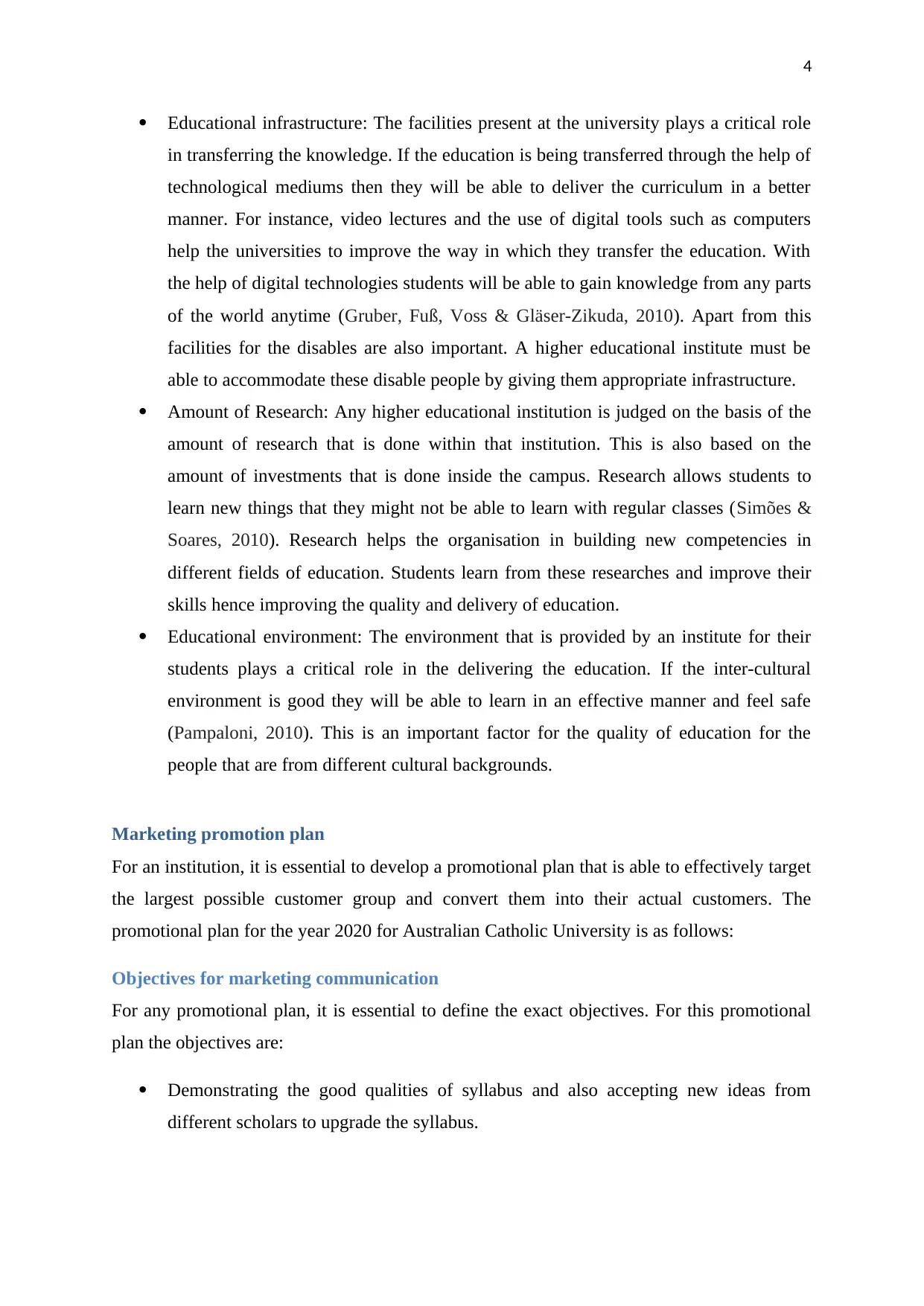
4
Educational infrastructure: The facilities present at the university plays a critical role
in transferring the knowledge. If the education is being transferred through the help of
technological mediums then they will be able to deliver the curriculum in a better
manner. For instance, video lectures and the use of digital tools such as computers
help the universities to improve the way in which they transfer the education. With
the help of digital technologies students will be able to gain knowledge from any parts
of the world anytime (Gruber, Fuß, Voss & Gläser-Zikuda, 2010). Apart from this
facilities for the disables are also important. A higher educational institute must be
able to accommodate these disable people by giving them appropriate infrastructure.
Amount of Research: Any higher educational institution is judged on the basis of the
amount of research that is done within that institution. This is also based on the
amount of investments that is done inside the campus. Research allows students to
learn new things that they might not be able to learn with regular classes (Simões &
Soares, 2010). Research helps the organisation in building new competencies in
different fields of education. Students learn from these researches and improve their
skills hence improving the quality and delivery of education.
Educational environment: The environment that is provided by an institute for their
students plays a critical role in the delivering the education. If the inter-cultural
environment is good they will be able to learn in an effective manner and feel safe
(Pampaloni, 2010). This is an important factor for the quality of education for the
people that are from different cultural backgrounds.
Marketing promotion plan
For an institution, it is essential to develop a promotional plan that is able to effectively target
the largest possible customer group and convert them into their actual customers. The
promotional plan for the year 2020 for Australian Catholic University is as follows:
Objectives for marketing communication
For any promotional plan, it is essential to define the exact objectives. For this promotional
plan the objectives are:
Demonstrating the good qualities of syllabus and also accepting new ideas from
different scholars to upgrade the syllabus.
Educational infrastructure: The facilities present at the university plays a critical role
in transferring the knowledge. If the education is being transferred through the help of
technological mediums then they will be able to deliver the curriculum in a better
manner. For instance, video lectures and the use of digital tools such as computers
help the universities to improve the way in which they transfer the education. With
the help of digital technologies students will be able to gain knowledge from any parts
of the world anytime (Gruber, Fuß, Voss & Gläser-Zikuda, 2010). Apart from this
facilities for the disables are also important. A higher educational institute must be
able to accommodate these disable people by giving them appropriate infrastructure.
Amount of Research: Any higher educational institution is judged on the basis of the
amount of research that is done within that institution. This is also based on the
amount of investments that is done inside the campus. Research allows students to
learn new things that they might not be able to learn with regular classes (Simões &
Soares, 2010). Research helps the organisation in building new competencies in
different fields of education. Students learn from these researches and improve their
skills hence improving the quality and delivery of education.
Educational environment: The environment that is provided by an institute for their
students plays a critical role in the delivering the education. If the inter-cultural
environment is good they will be able to learn in an effective manner and feel safe
(Pampaloni, 2010). This is an important factor for the quality of education for the
people that are from different cultural backgrounds.
Marketing promotion plan
For an institution, it is essential to develop a promotional plan that is able to effectively target
the largest possible customer group and convert them into their actual customers. The
promotional plan for the year 2020 for Australian Catholic University is as follows:
Objectives for marketing communication
For any promotional plan, it is essential to define the exact objectives. For this promotional
plan the objectives are:
Demonstrating the good qualities of syllabus and also accepting new ideas from
different scholars to upgrade the syllabus.
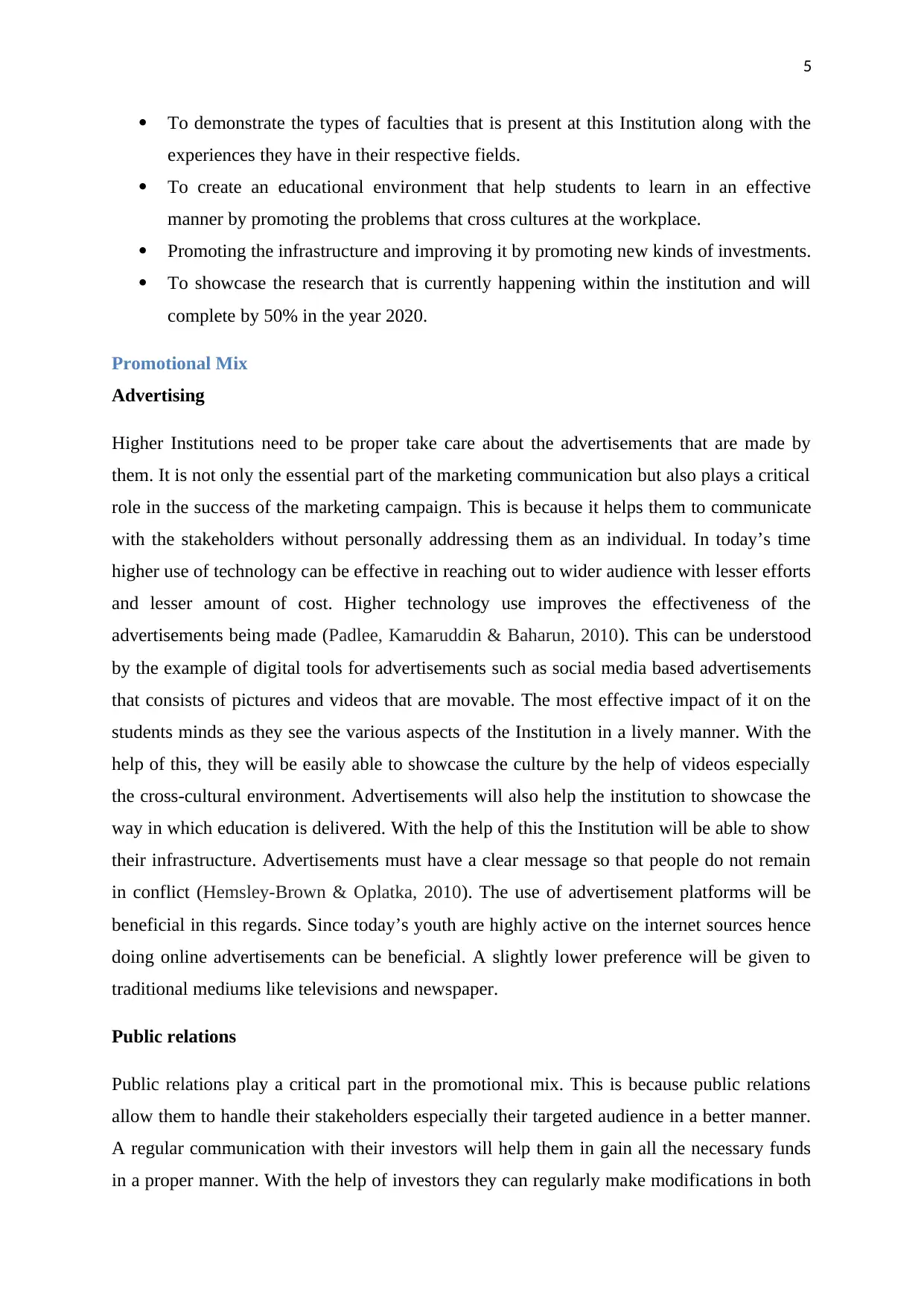
5
To demonstrate the types of faculties that is present at this Institution along with the
experiences they have in their respective fields.
To create an educational environment that help students to learn in an effective
manner by promoting the problems that cross cultures at the workplace.
Promoting the infrastructure and improving it by promoting new kinds of investments.
To showcase the research that is currently happening within the institution and will
complete by 50% in the year 2020.
Promotional Mix
Advertising
Higher Institutions need to be proper take care about the advertisements that are made by
them. It is not only the essential part of the marketing communication but also plays a critical
role in the success of the marketing campaign. This is because it helps them to communicate
with the stakeholders without personally addressing them as an individual. In today’s time
higher use of technology can be effective in reaching out to wider audience with lesser efforts
and lesser amount of cost. Higher technology use improves the effectiveness of the
advertisements being made (Padlee, Kamaruddin & Baharun, 2010). This can be understood
by the example of digital tools for advertisements such as social media based advertisements
that consists of pictures and videos that are movable. The most effective impact of it on the
students minds as they see the various aspects of the Institution in a lively manner. With the
help of this, they will be easily able to showcase the culture by the help of videos especially
the cross-cultural environment. Advertisements will also help the institution to showcase the
way in which education is delivered. With the help of this the Institution will be able to show
their infrastructure. Advertisements must have a clear message so that people do not remain
in conflict (Hemsley-Brown & Oplatka, 2010). The use of advertisement platforms will be
beneficial in this regards. Since today’s youth are highly active on the internet sources hence
doing online advertisements can be beneficial. A slightly lower preference will be given to
traditional mediums like televisions and newspaper.
Public relations
Public relations play a critical part in the promotional mix. This is because public relations
allow them to handle their stakeholders especially their targeted audience in a better manner.
A regular communication with their investors will help them in gain all the necessary funds
in a proper manner. With the help of investors they can regularly make modifications in both
To demonstrate the types of faculties that is present at this Institution along with the
experiences they have in their respective fields.
To create an educational environment that help students to learn in an effective
manner by promoting the problems that cross cultures at the workplace.
Promoting the infrastructure and improving it by promoting new kinds of investments.
To showcase the research that is currently happening within the institution and will
complete by 50% in the year 2020.
Promotional Mix
Advertising
Higher Institutions need to be proper take care about the advertisements that are made by
them. It is not only the essential part of the marketing communication but also plays a critical
role in the success of the marketing campaign. This is because it helps them to communicate
with the stakeholders without personally addressing them as an individual. In today’s time
higher use of technology can be effective in reaching out to wider audience with lesser efforts
and lesser amount of cost. Higher technology use improves the effectiveness of the
advertisements being made (Padlee, Kamaruddin & Baharun, 2010). This can be understood
by the example of digital tools for advertisements such as social media based advertisements
that consists of pictures and videos that are movable. The most effective impact of it on the
students minds as they see the various aspects of the Institution in a lively manner. With the
help of this, they will be easily able to showcase the culture by the help of videos especially
the cross-cultural environment. Advertisements will also help the institution to showcase the
way in which education is delivered. With the help of this the Institution will be able to show
their infrastructure. Advertisements must have a clear message so that people do not remain
in conflict (Hemsley-Brown & Oplatka, 2010). The use of advertisement platforms will be
beneficial in this regards. Since today’s youth are highly active on the internet sources hence
doing online advertisements can be beneficial. A slightly lower preference will be given to
traditional mediums like televisions and newspaper.
Public relations
Public relations play a critical part in the promotional mix. This is because public relations
allow them to handle their stakeholders especially their targeted audience in a better manner.
A regular communication with their investors will help them in gain all the necessary funds
in a proper manner. With the help of investors they can regularly make modifications in both
⊘ This is a preview!⊘
Do you want full access?
Subscribe today to unlock all pages.

Trusted by 1+ million students worldwide
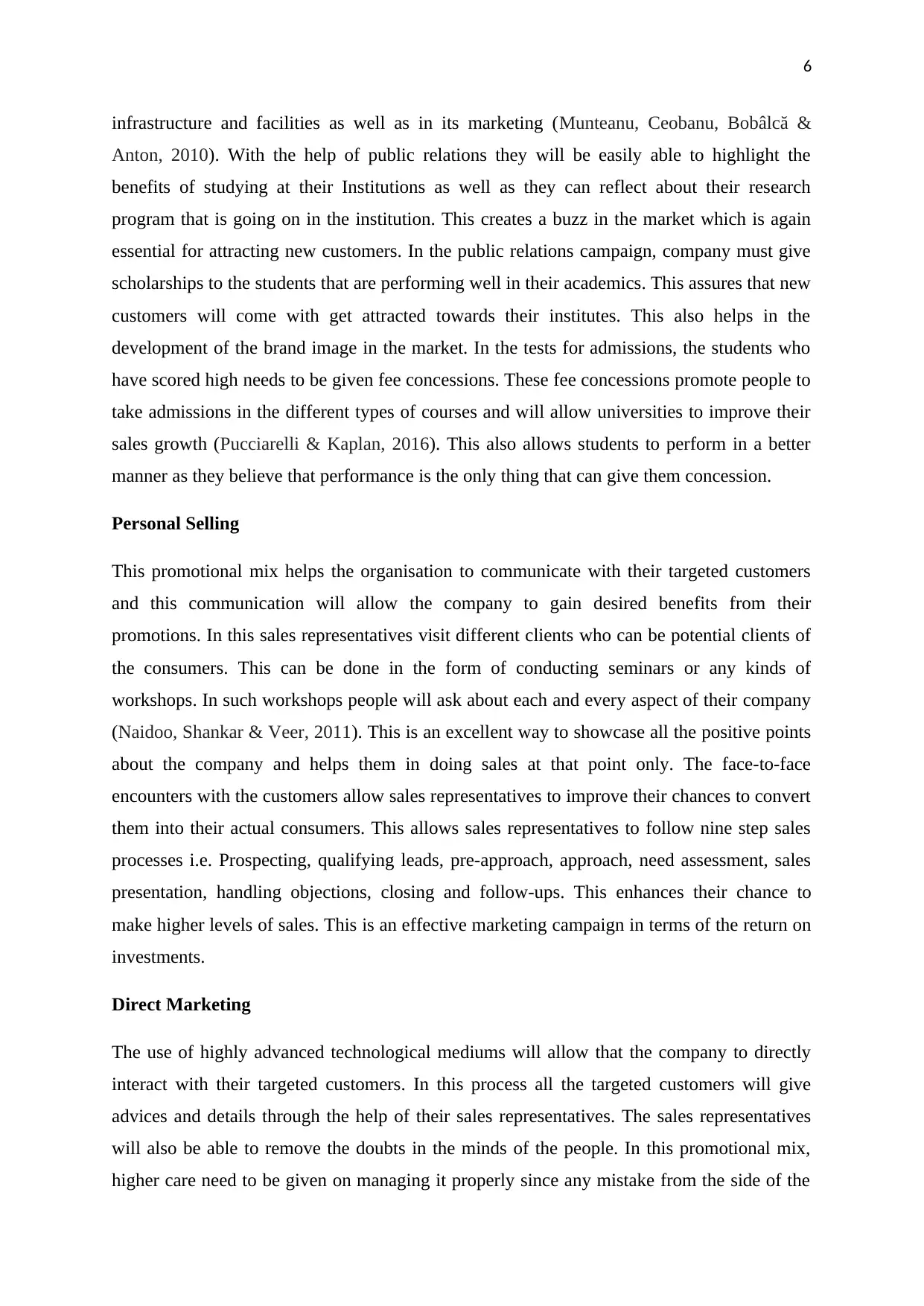
6
infrastructure and facilities as well as in its marketing (Munteanu, Ceobanu, Bobâlcă &
Anton, 2010). With the help of public relations they will be easily able to highlight the
benefits of studying at their Institutions as well as they can reflect about their research
program that is going on in the institution. This creates a buzz in the market which is again
essential for attracting new customers. In the public relations campaign, company must give
scholarships to the students that are performing well in their academics. This assures that new
customers will come with get attracted towards their institutes. This also helps in the
development of the brand image in the market. In the tests for admissions, the students who
have scored high needs to be given fee concessions. These fee concessions promote people to
take admissions in the different types of courses and will allow universities to improve their
sales growth (Pucciarelli & Kaplan, 2016). This also allows students to perform in a better
manner as they believe that performance is the only thing that can give them concession.
Personal Selling
This promotional mix helps the organisation to communicate with their targeted customers
and this communication will allow the company to gain desired benefits from their
promotions. In this sales representatives visit different clients who can be potential clients of
the consumers. This can be done in the form of conducting seminars or any kinds of
workshops. In such workshops people will ask about each and every aspect of their company
(Naidoo, Shankar & Veer, 2011). This is an excellent way to showcase all the positive points
about the company and helps them in doing sales at that point only. The face-to-face
encounters with the customers allow sales representatives to improve their chances to convert
them into their actual consumers. This allows sales representatives to follow nine step sales
processes i.e. Prospecting, qualifying leads, pre-approach, approach, need assessment, sales
presentation, handling objections, closing and follow-ups. This enhances their chance to
make higher levels of sales. This is an effective marketing campaign in terms of the return on
investments.
Direct Marketing
The use of highly advanced technological mediums will allow that the company to directly
interact with their targeted customers. In this process all the targeted customers will give
advices and details through the help of their sales representatives. The sales representatives
will also be able to remove the doubts in the minds of the people. In this promotional mix,
higher care need to be given on managing it properly since any mistake from the side of the
infrastructure and facilities as well as in its marketing (Munteanu, Ceobanu, Bobâlcă &
Anton, 2010). With the help of public relations they will be easily able to highlight the
benefits of studying at their Institutions as well as they can reflect about their research
program that is going on in the institution. This creates a buzz in the market which is again
essential for attracting new customers. In the public relations campaign, company must give
scholarships to the students that are performing well in their academics. This assures that new
customers will come with get attracted towards their institutes. This also helps in the
development of the brand image in the market. In the tests for admissions, the students who
have scored high needs to be given fee concessions. These fee concessions promote people to
take admissions in the different types of courses and will allow universities to improve their
sales growth (Pucciarelli & Kaplan, 2016). This also allows students to perform in a better
manner as they believe that performance is the only thing that can give them concession.
Personal Selling
This promotional mix helps the organisation to communicate with their targeted customers
and this communication will allow the company to gain desired benefits from their
promotions. In this sales representatives visit different clients who can be potential clients of
the consumers. This can be done in the form of conducting seminars or any kinds of
workshops. In such workshops people will ask about each and every aspect of their company
(Naidoo, Shankar & Veer, 2011). This is an excellent way to showcase all the positive points
about the company and helps them in doing sales at that point only. The face-to-face
encounters with the customers allow sales representatives to improve their chances to convert
them into their actual consumers. This allows sales representatives to follow nine step sales
processes i.e. Prospecting, qualifying leads, pre-approach, approach, need assessment, sales
presentation, handling objections, closing and follow-ups. This enhances their chance to
make higher levels of sales. This is an effective marketing campaign in terms of the return on
investments.
Direct Marketing
The use of highly advanced technological mediums will allow that the company to directly
interact with their targeted customers. In this process all the targeted customers will give
advices and details through the help of their sales representatives. The sales representatives
will also be able to remove the doubts in the minds of the people. In this promotional mix,
higher care need to be given on managing it properly since any mistake from the side of the
Paraphrase This Document
Need a fresh take? Get an instant paraphrase of this document with our AI Paraphraser
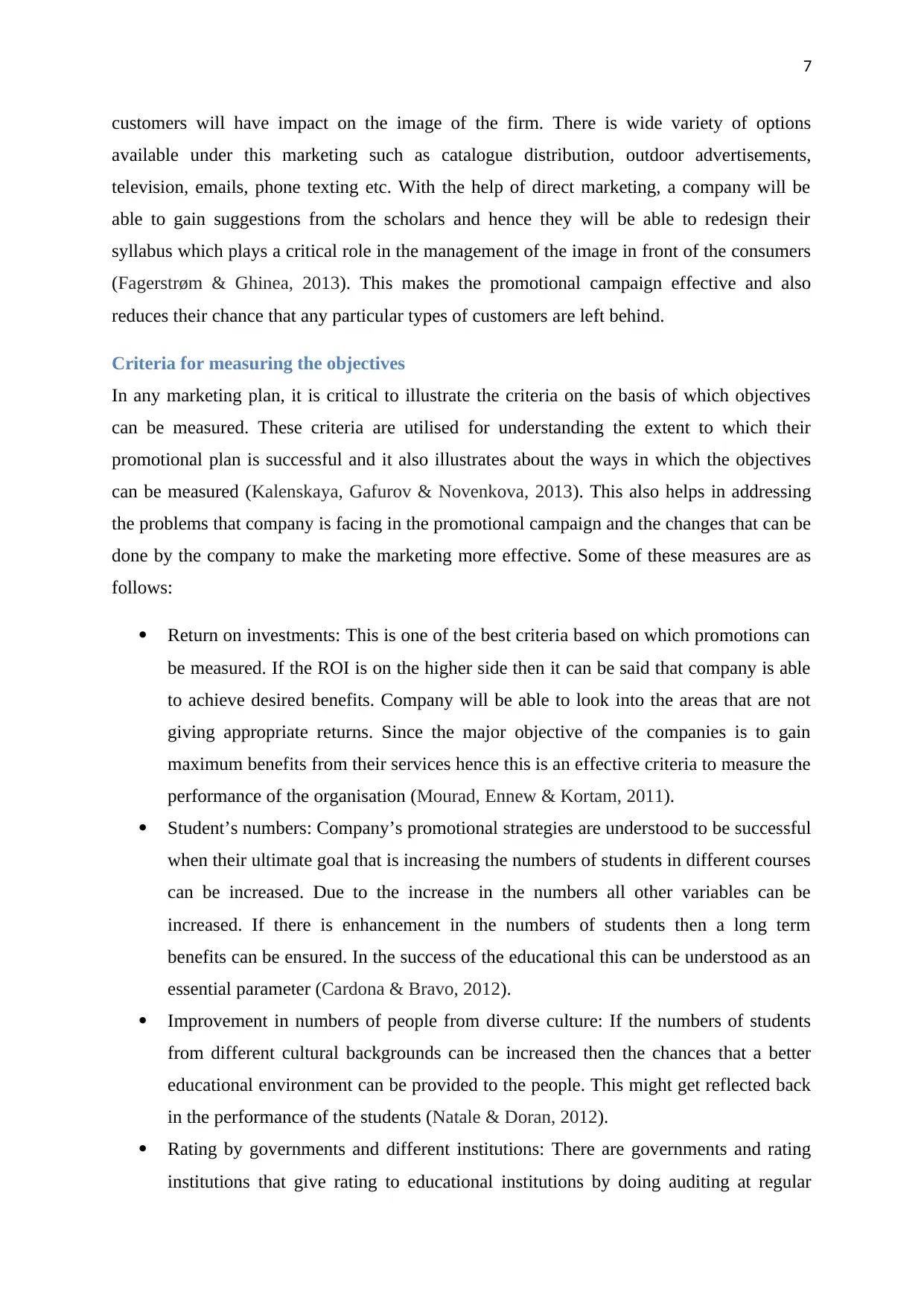
7
customers will have impact on the image of the firm. There is wide variety of options
available under this marketing such as catalogue distribution, outdoor advertisements,
television, emails, phone texting etc. With the help of direct marketing, a company will be
able to gain suggestions from the scholars and hence they will be able to redesign their
syllabus which plays a critical role in the management of the image in front of the consumers
(Fagerstrøm & Ghinea, 2013). This makes the promotional campaign effective and also
reduces their chance that any particular types of customers are left behind.
Criteria for measuring the objectives
In any marketing plan, it is critical to illustrate the criteria on the basis of which objectives
can be measured. These criteria are utilised for understanding the extent to which their
promotional plan is successful and it also illustrates about the ways in which the objectives
can be measured (Kalenskaya, Gafurov & Novenkova, 2013). This also helps in addressing
the problems that company is facing in the promotional campaign and the changes that can be
done by the company to make the marketing more effective. Some of these measures are as
follows:
Return on investments: This is one of the best criteria based on which promotions can
be measured. If the ROI is on the higher side then it can be said that company is able
to achieve desired benefits. Company will be able to look into the areas that are not
giving appropriate returns. Since the major objective of the companies is to gain
maximum benefits from their services hence this is an effective criteria to measure the
performance of the organisation (Mourad, Ennew & Kortam, 2011).
Student’s numbers: Company’s promotional strategies are understood to be successful
when their ultimate goal that is increasing the numbers of students in different courses
can be increased. Due to the increase in the numbers all other variables can be
increased. If there is enhancement in the numbers of students then a long term
benefits can be ensured. In the success of the educational this can be understood as an
essential parameter (Cardona & Bravo, 2012).
Improvement in numbers of people from diverse culture: If the numbers of students
from different cultural backgrounds can be increased then the chances that a better
educational environment can be provided to the people. This might get reflected back
in the performance of the students (Natale & Doran, 2012).
Rating by governments and different institutions: There are governments and rating
institutions that give rating to educational institutions by doing auditing at regular
customers will have impact on the image of the firm. There is wide variety of options
available under this marketing such as catalogue distribution, outdoor advertisements,
television, emails, phone texting etc. With the help of direct marketing, a company will be
able to gain suggestions from the scholars and hence they will be able to redesign their
syllabus which plays a critical role in the management of the image in front of the consumers
(Fagerstrøm & Ghinea, 2013). This makes the promotional campaign effective and also
reduces their chance that any particular types of customers are left behind.
Criteria for measuring the objectives
In any marketing plan, it is critical to illustrate the criteria on the basis of which objectives
can be measured. These criteria are utilised for understanding the extent to which their
promotional plan is successful and it also illustrates about the ways in which the objectives
can be measured (Kalenskaya, Gafurov & Novenkova, 2013). This also helps in addressing
the problems that company is facing in the promotional campaign and the changes that can be
done by the company to make the marketing more effective. Some of these measures are as
follows:
Return on investments: This is one of the best criteria based on which promotions can
be measured. If the ROI is on the higher side then it can be said that company is able
to achieve desired benefits. Company will be able to look into the areas that are not
giving appropriate returns. Since the major objective of the companies is to gain
maximum benefits from their services hence this is an effective criteria to measure the
performance of the organisation (Mourad, Ennew & Kortam, 2011).
Student’s numbers: Company’s promotional strategies are understood to be successful
when their ultimate goal that is increasing the numbers of students in different courses
can be increased. Due to the increase in the numbers all other variables can be
increased. If there is enhancement in the numbers of students then a long term
benefits can be ensured. In the success of the educational this can be understood as an
essential parameter (Cardona & Bravo, 2012).
Improvement in numbers of people from diverse culture: If the numbers of students
from different cultural backgrounds can be increased then the chances that a better
educational environment can be provided to the people. This might get reflected back
in the performance of the students (Natale & Doran, 2012).
Rating by governments and different institutions: There are governments and rating
institutions that give rating to educational institutions by doing auditing at regular
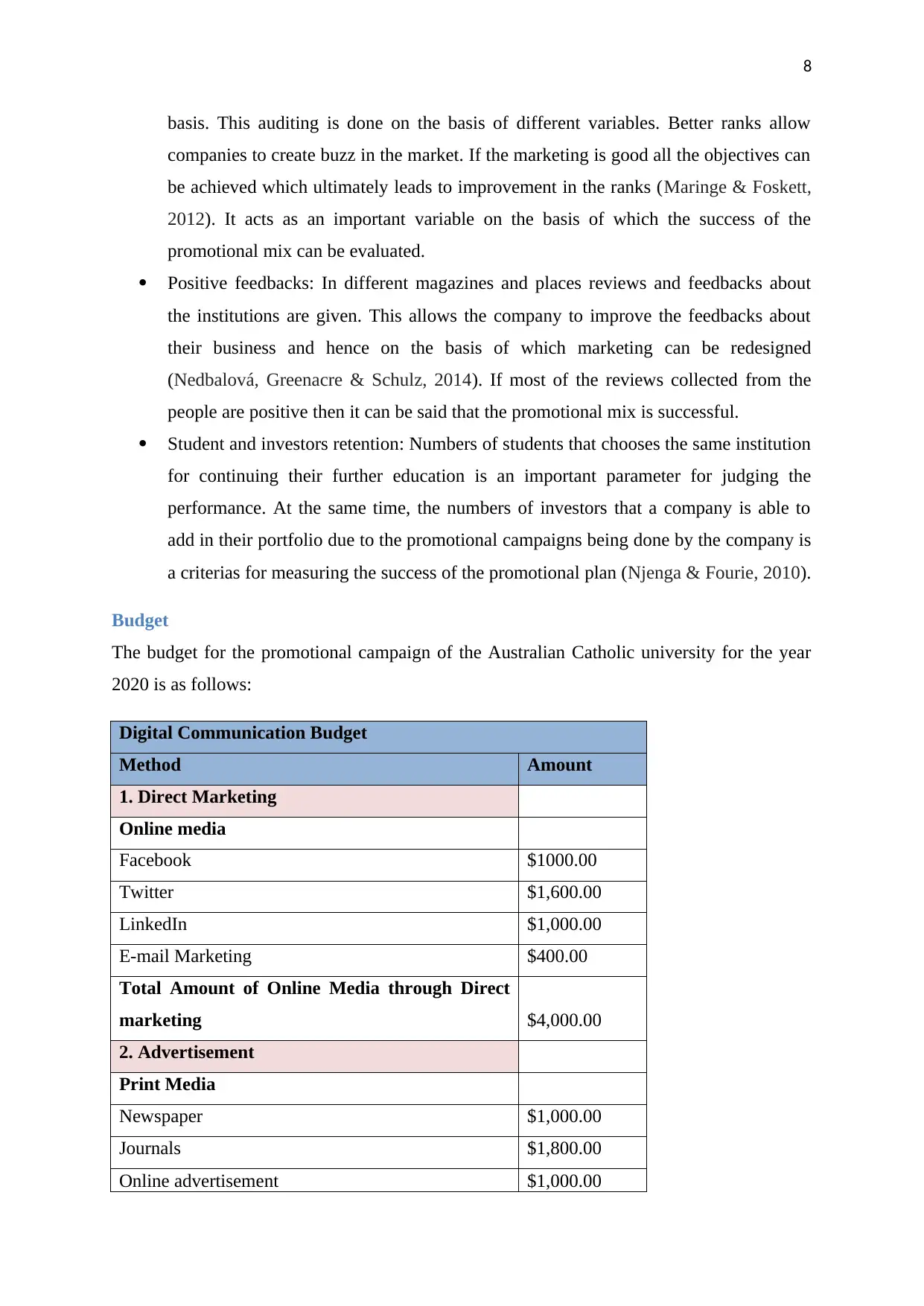
8
basis. This auditing is done on the basis of different variables. Better ranks allow
companies to create buzz in the market. If the marketing is good all the objectives can
be achieved which ultimately leads to improvement in the ranks (Maringe & Foskett,
2012). It acts as an important variable on the basis of which the success of the
promotional mix can be evaluated.
Positive feedbacks: In different magazines and places reviews and feedbacks about
the institutions are given. This allows the company to improve the feedbacks about
their business and hence on the basis of which marketing can be redesigned
(Nedbalová, Greenacre & Schulz, 2014). If most of the reviews collected from the
people are positive then it can be said that the promotional mix is successful.
Student and investors retention: Numbers of students that chooses the same institution
for continuing their further education is an important parameter for judging the
performance. At the same time, the numbers of investors that a company is able to
add in their portfolio due to the promotional campaigns being done by the company is
a criterias for measuring the success of the promotional plan (Njenga & Fourie, 2010).
Budget
The budget for the promotional campaign of the Australian Catholic university for the year
2020 is as follows:
Digital Communication Budget
Method Amount
1. Direct Marketing
Online media
Facebook $1000.00
Twitter $1,600.00
LinkedIn $1,000.00
E-mail Marketing $400.00
Total Amount of Online Media through Direct
marketing $4,000.00
2. Advertisement
Print Media
Newspaper $1,000.00
Journals $1,800.00
Online advertisement $1,000.00
basis. This auditing is done on the basis of different variables. Better ranks allow
companies to create buzz in the market. If the marketing is good all the objectives can
be achieved which ultimately leads to improvement in the ranks (Maringe & Foskett,
2012). It acts as an important variable on the basis of which the success of the
promotional mix can be evaluated.
Positive feedbacks: In different magazines and places reviews and feedbacks about
the institutions are given. This allows the company to improve the feedbacks about
their business and hence on the basis of which marketing can be redesigned
(Nedbalová, Greenacre & Schulz, 2014). If most of the reviews collected from the
people are positive then it can be said that the promotional mix is successful.
Student and investors retention: Numbers of students that chooses the same institution
for continuing their further education is an important parameter for judging the
performance. At the same time, the numbers of investors that a company is able to
add in their portfolio due to the promotional campaigns being done by the company is
a criterias for measuring the success of the promotional plan (Njenga & Fourie, 2010).
Budget
The budget for the promotional campaign of the Australian Catholic university for the year
2020 is as follows:
Digital Communication Budget
Method Amount
1. Direct Marketing
Online media
Facebook $1000.00
Twitter $1,600.00
LinkedIn $1,000.00
E-mail Marketing $400.00
Total Amount of Online Media through Direct
marketing $4,000.00
2. Advertisement
Print Media
Newspaper $1,000.00
Journals $1,800.00
Online advertisement $1,000.00
⊘ This is a preview!⊘
Do you want full access?
Subscribe today to unlock all pages.

Trusted by 1+ million students worldwide
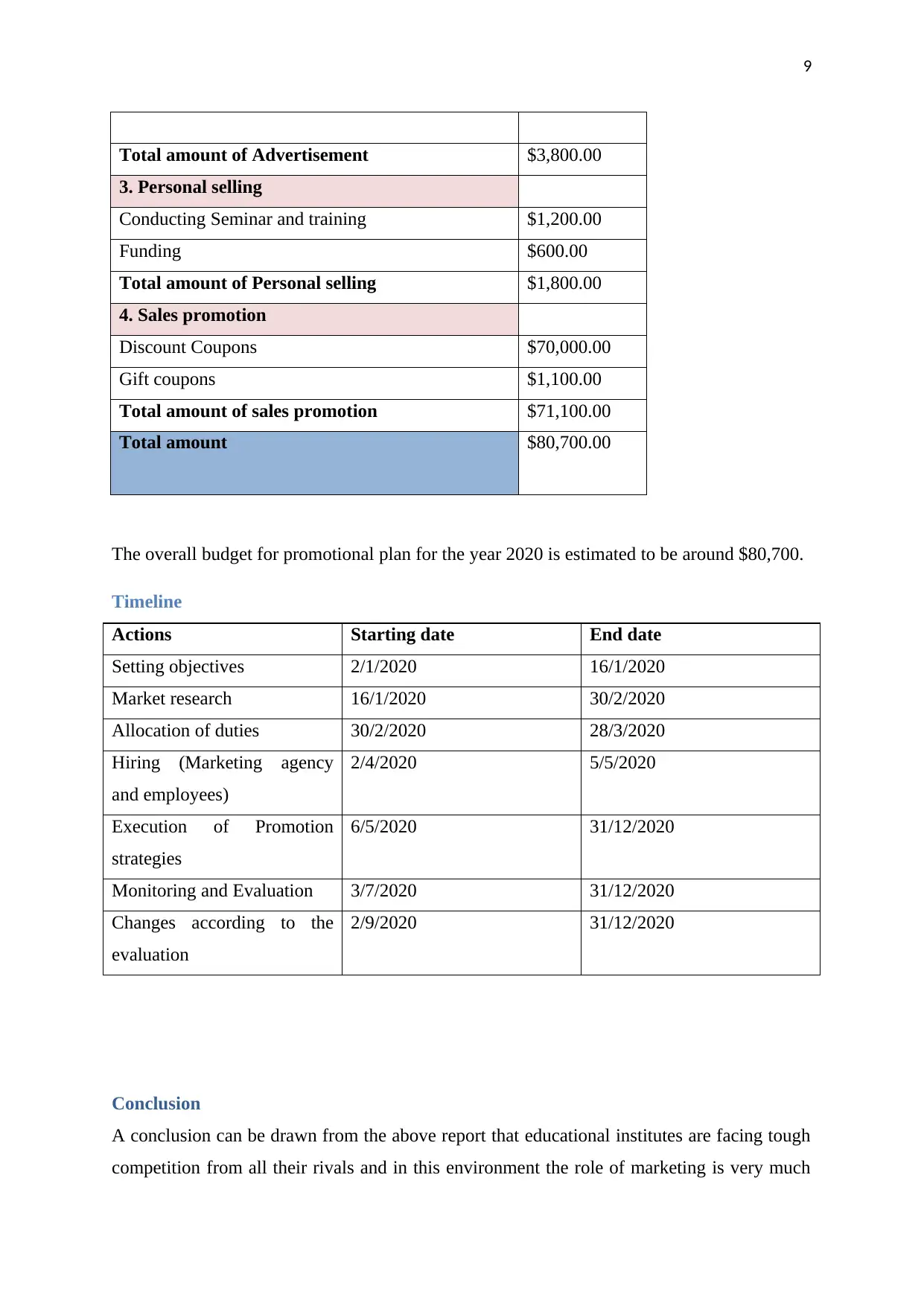
9
Total amount of Advertisement $3,800.00
3. Personal selling
Conducting Seminar and training $1,200.00
Funding $600.00
Total amount of Personal selling $1,800.00
4. Sales promotion
Discount Coupons $70,000.00
Gift coupons $1,100.00
Total amount of sales promotion $71,100.00
Total amount $80,700.00
The overall budget for promotional plan for the year 2020 is estimated to be around $80,700.
Timeline
Actions Starting date End date
Setting objectives 2/1/2020 16/1/2020
Market research 16/1/2020 30/2/2020
Allocation of duties 30/2/2020 28/3/2020
Hiring (Marketing agency
and employees)
2/4/2020 5/5/2020
Execution of Promotion
strategies
6/5/2020 31/12/2020
Monitoring and Evaluation 3/7/2020 31/12/2020
Changes according to the
evaluation
2/9/2020 31/12/2020
Conclusion
A conclusion can be drawn from the above report that educational institutes are facing tough
competition from all their rivals and in this environment the role of marketing is very much
Total amount of Advertisement $3,800.00
3. Personal selling
Conducting Seminar and training $1,200.00
Funding $600.00
Total amount of Personal selling $1,800.00
4. Sales promotion
Discount Coupons $70,000.00
Gift coupons $1,100.00
Total amount of sales promotion $71,100.00
Total amount $80,700.00
The overall budget for promotional plan for the year 2020 is estimated to be around $80,700.
Timeline
Actions Starting date End date
Setting objectives 2/1/2020 16/1/2020
Market research 16/1/2020 30/2/2020
Allocation of duties 30/2/2020 28/3/2020
Hiring (Marketing agency
and employees)
2/4/2020 5/5/2020
Execution of Promotion
strategies
6/5/2020 31/12/2020
Monitoring and Evaluation 3/7/2020 31/12/2020
Changes according to the
evaluation
2/9/2020 31/12/2020
Conclusion
A conclusion can be drawn from the above report that educational institutes are facing tough
competition from all their rivals and in this environment the role of marketing is very much
Paraphrase This Document
Need a fresh take? Get an instant paraphrase of this document with our AI Paraphraser
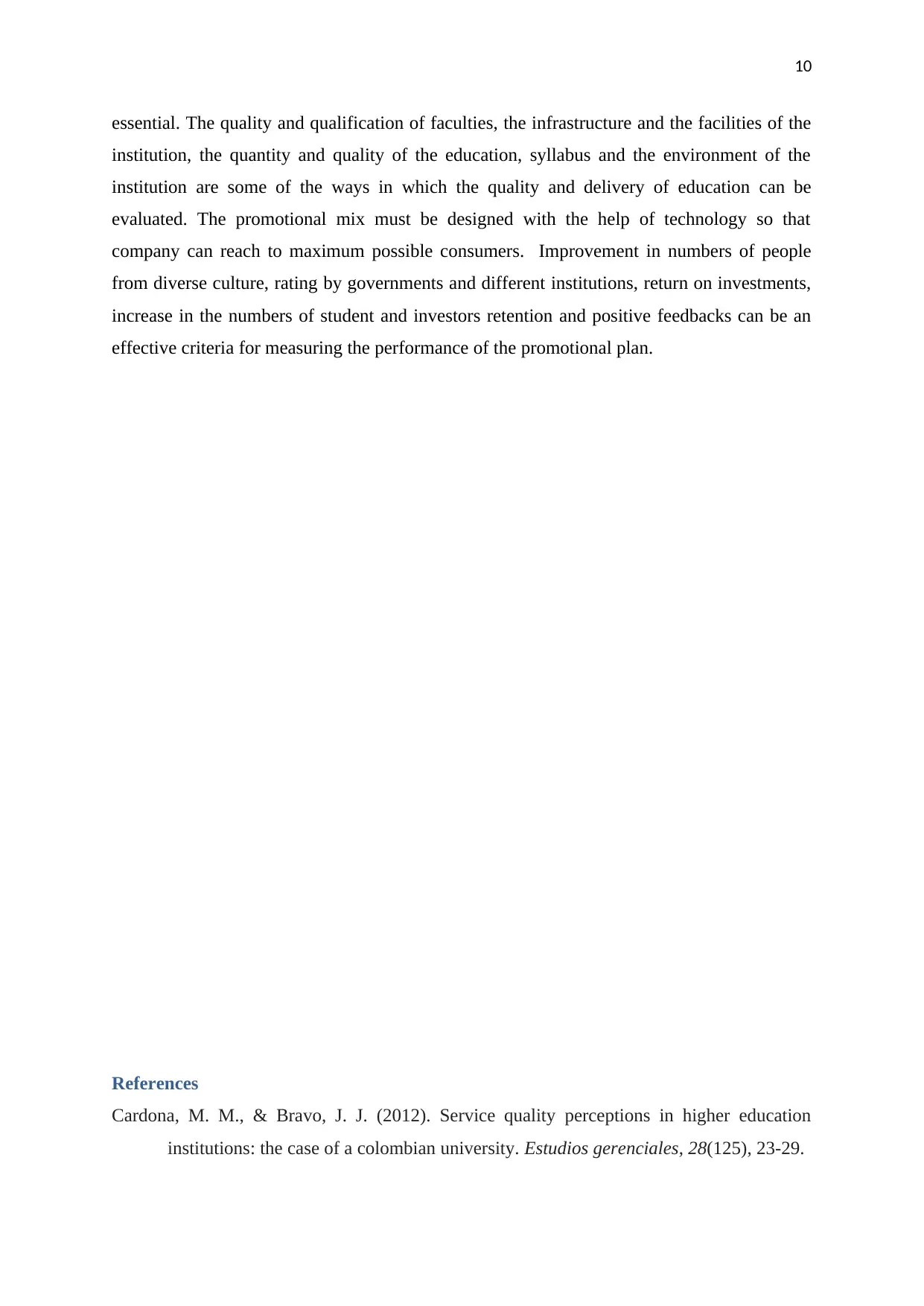
10
essential. The quality and qualification of faculties, the infrastructure and the facilities of the
institution, the quantity and quality of the education, syllabus and the environment of the
institution are some of the ways in which the quality and delivery of education can be
evaluated. The promotional mix must be designed with the help of technology so that
company can reach to maximum possible consumers. Improvement in numbers of people
from diverse culture, rating by governments and different institutions, return on investments,
increase in the numbers of student and investors retention and positive feedbacks can be an
effective criteria for measuring the performance of the promotional plan.
References
Cardona, M. M., & Bravo, J. J. (2012). Service quality perceptions in higher education
institutions: the case of a colombian university. Estudios gerenciales, 28(125), 23-29.
essential. The quality and qualification of faculties, the infrastructure and the facilities of the
institution, the quantity and quality of the education, syllabus and the environment of the
institution are some of the ways in which the quality and delivery of education can be
evaluated. The promotional mix must be designed with the help of technology so that
company can reach to maximum possible consumers. Improvement in numbers of people
from diverse culture, rating by governments and different institutions, return on investments,
increase in the numbers of student and investors retention and positive feedbacks can be an
effective criteria for measuring the performance of the promotional plan.
References
Cardona, M. M., & Bravo, J. J. (2012). Service quality perceptions in higher education
institutions: the case of a colombian university. Estudios gerenciales, 28(125), 23-29.
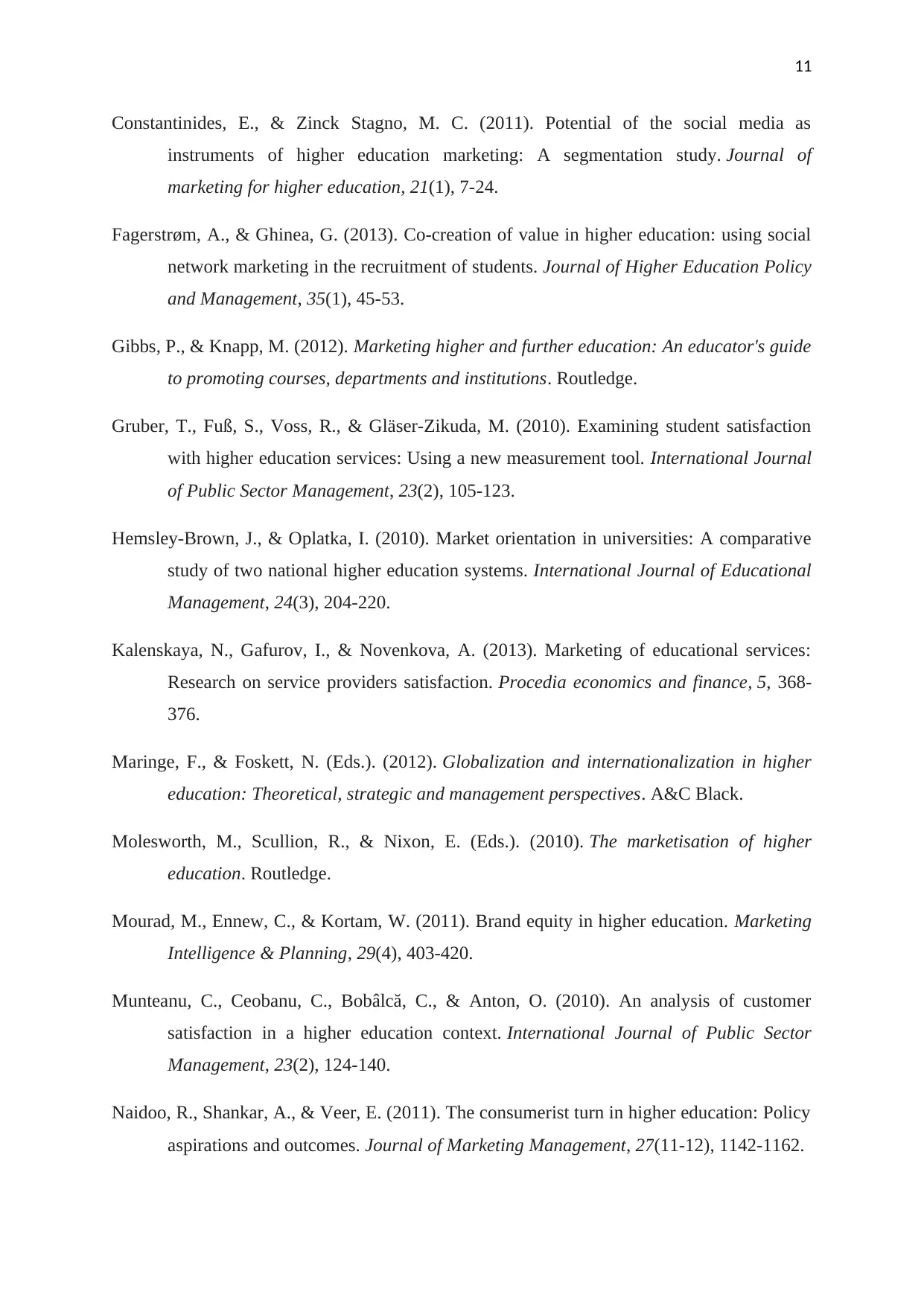
11
Constantinides, E., & Zinck Stagno, M. C. (2011). Potential of the social media as
instruments of higher education marketing: A segmentation study. Journal of
marketing for higher education, 21(1), 7-24.
Fagerstrøm, A., & Ghinea, G. (2013). Co-creation of value in higher education: using social
network marketing in the recruitment of students. Journal of Higher Education Policy
and Management, 35(1), 45-53.
Gibbs, P., & Knapp, M. (2012). Marketing higher and further education: An educator's guide
to promoting courses, departments and institutions. Routledge.
Gruber, T., Fuß, S., Voss, R., & Gläser-Zikuda, M. (2010). Examining student satisfaction
with higher education services: Using a new measurement tool. International Journal
of Public Sector Management, 23(2), 105-123.
Hemsley-Brown, J., & Oplatka, I. (2010). Market orientation in universities: A comparative
study of two national higher education systems. International Journal of Educational
Management, 24(3), 204-220.
Kalenskaya, N., Gafurov, I., & Novenkova, A. (2013). Marketing of educational services:
Research on service providers satisfaction. Procedia economics and finance, 5, 368-
376.
Maringe, F., & Foskett, N. (Eds.). (2012). Globalization and internationalization in higher
education: Theoretical, strategic and management perspectives. A&C Black.
Molesworth, M., Scullion, R., & Nixon, E. (Eds.). (2010). The marketisation of higher
education. Routledge.
Mourad, M., Ennew, C., & Kortam, W. (2011). Brand equity in higher education. Marketing
Intelligence & Planning, 29(4), 403-420.
Munteanu, C., Ceobanu, C., Bobâlcă, C., & Anton, O. (2010). An analysis of customer
satisfaction in a higher education context. International Journal of Public Sector
Management, 23(2), 124-140.
Naidoo, R., Shankar, A., & Veer, E. (2011). The consumerist turn in higher education: Policy
aspirations and outcomes. Journal of Marketing Management, 27(11-12), 1142-1162.
Constantinides, E., & Zinck Stagno, M. C. (2011). Potential of the social media as
instruments of higher education marketing: A segmentation study. Journal of
marketing for higher education, 21(1), 7-24.
Fagerstrøm, A., & Ghinea, G. (2013). Co-creation of value in higher education: using social
network marketing in the recruitment of students. Journal of Higher Education Policy
and Management, 35(1), 45-53.
Gibbs, P., & Knapp, M. (2012). Marketing higher and further education: An educator's guide
to promoting courses, departments and institutions. Routledge.
Gruber, T., Fuß, S., Voss, R., & Gläser-Zikuda, M. (2010). Examining student satisfaction
with higher education services: Using a new measurement tool. International Journal
of Public Sector Management, 23(2), 105-123.
Hemsley-Brown, J., & Oplatka, I. (2010). Market orientation in universities: A comparative
study of two national higher education systems. International Journal of Educational
Management, 24(3), 204-220.
Kalenskaya, N., Gafurov, I., & Novenkova, A. (2013). Marketing of educational services:
Research on service providers satisfaction. Procedia economics and finance, 5, 368-
376.
Maringe, F., & Foskett, N. (Eds.). (2012). Globalization and internationalization in higher
education: Theoretical, strategic and management perspectives. A&C Black.
Molesworth, M., Scullion, R., & Nixon, E. (Eds.). (2010). The marketisation of higher
education. Routledge.
Mourad, M., Ennew, C., & Kortam, W. (2011). Brand equity in higher education. Marketing
Intelligence & Planning, 29(4), 403-420.
Munteanu, C., Ceobanu, C., Bobâlcă, C., & Anton, O. (2010). An analysis of customer
satisfaction in a higher education context. International Journal of Public Sector
Management, 23(2), 124-140.
Naidoo, R., Shankar, A., & Veer, E. (2011). The consumerist turn in higher education: Policy
aspirations and outcomes. Journal of Marketing Management, 27(11-12), 1142-1162.
⊘ This is a preview!⊘
Do you want full access?
Subscribe today to unlock all pages.

Trusted by 1+ million students worldwide
1 out of 13
Related Documents
Your All-in-One AI-Powered Toolkit for Academic Success.
+13062052269
info@desklib.com
Available 24*7 on WhatsApp / Email
![[object Object]](/_next/static/media/star-bottom.7253800d.svg)
Unlock your academic potential
Copyright © 2020–2025 A2Z Services. All Rights Reserved. Developed and managed by ZUCOL.





